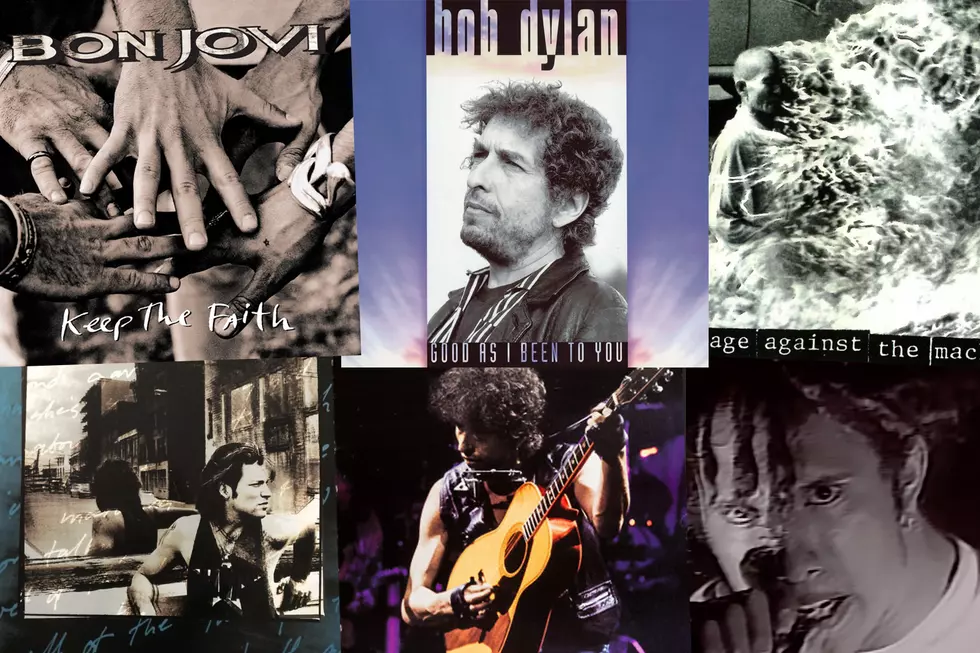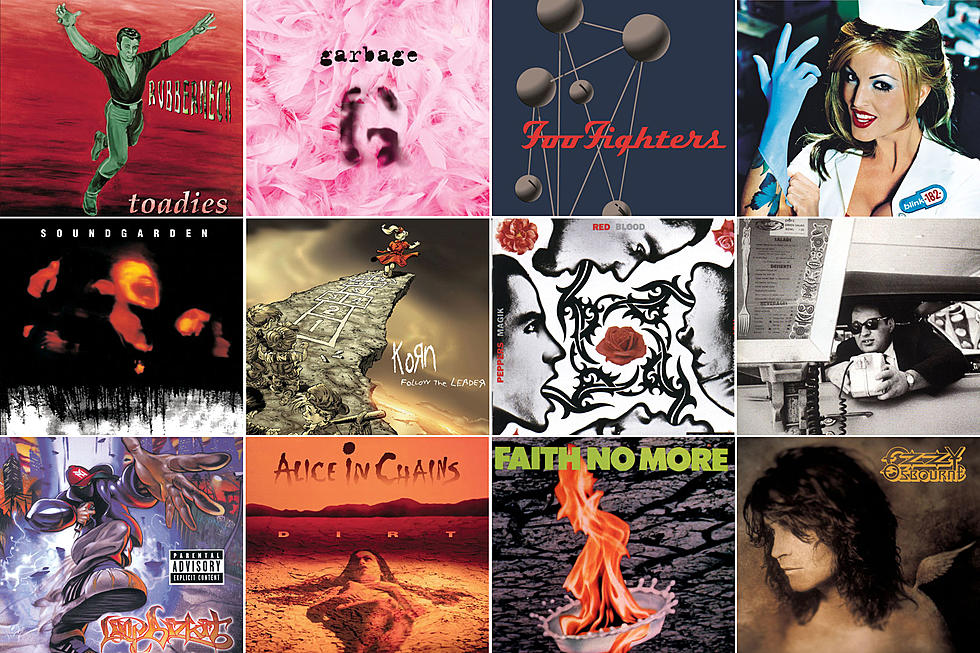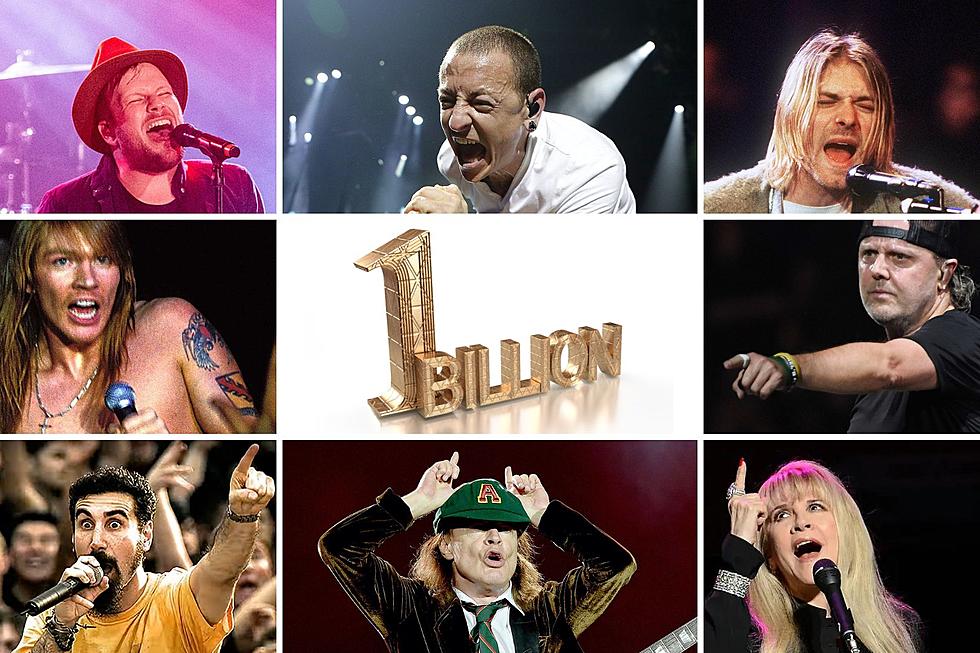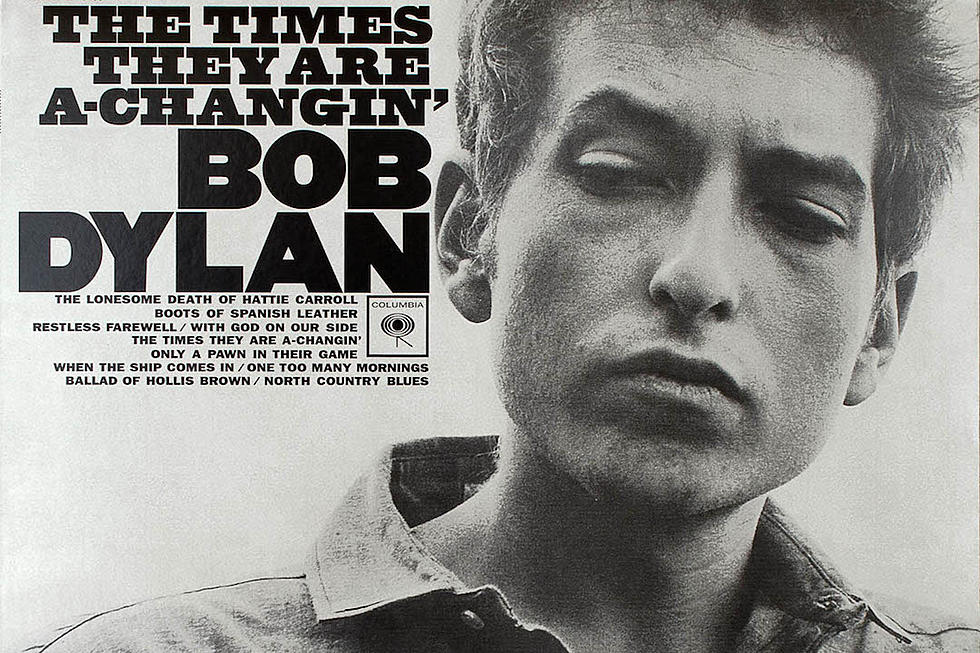
The Day Bon Jovi, Bob Dylan and RATM All Released Albums
The rock world was undergoing a seismic shift at the dawn of the '90s. The spandex-clad, sex-obsessed party-rockers who dominated the '80s were forced to adapt or die as a new breed of dour, more socially conscious rock and metal bands rose to power. At the same time, certain rock legends of yesteryear enjoyed career resurgences, fueled by renewed interest from younger generations and savvy artistic decisions that realigned them with their values.
To see all of these dynamics on display, look no further than Nov. 3, 1992: the day Bon Jovi, Bob Dylan and Rage Against the Machine released radically different albums that were successful on their own terms and marked career milestones for all three artists.
The most commercial successfully of the triumvirate — at least initially — was Bon Jovi's Keep the Faith. The Garden State rockers' fifth album arrived four years after 1988's chart-topping, seven-times platinum New Jersey. That blockbuster album and its gargantuan, 16-month world tour left the band exhausted, and when the trek wrapped in early 1990, Bon Jovi went on hiatus, giving frontman Jon Bon Jovi and guitarist Richie Sambora time to release solo albums: 1990's Young Guns II soundtrack and 1991's Stranger in This Town, respectively. When they regrouped, the namesake singer cleaned house, firing longtime manager Doc McGhee and assuming managerial duties himself by forming Bon Jovi Management.
The band also hired an outside mediator to help them work through their friction. "That was a saving grace for the band because we finally had a place where we could be honest and talk to each other about what was good, what was bad and what was indifferent," Bon Jovi told NPR in 2009. "And when you cleared the air and you realized, 'Wow, that was nothing, let's just go and make the next record,' everybody came back with a clear head. We went in two years later and made Keep the Faith."
Bon Jovi decamped to Vancouver's Little Mountain Sound Studios to work with superproducer Bob Rock, who'd recently helped Metallica and Motley Crue achieve groundbreaking success with 1991's Black Album and 1989's Dr. Feelgood, respectively. Grunge bands like Nirvana and Pearl Jam had rendered the glossy pop-metal anthems of Bon Jovi's mid-'80s heyday passe, but the band knew better than to chase trends. Instead, they made slight tweaks to their time-honored arena-rock template, adopting a rootsy, blues-rock bent on "I'll Sleep When I'm Dead" and "Blame It on the Love of Rock & Roll," delving deeper into melodramatic balladry on "Bed of Roses" and trying their hand at epic storytelling a la New Jersey's chief export, Bruce Springsteen, on the 10-minute "Dry County."
Keep the Faith reached No. 5 on the Billboard 200 and sold 2 million copies in the United States. It fell short of the band's mid-'80s albums, but it was a global smash, selling 12 million copies worldwide, and "Bed of Roses" became a Top 10 hit domestically. More importantly, it proved Bon Jovi could gracefully age out of the pop-metal anthems of their youth and successfully reinvent themselves for a new generation of listeners — a move they would pull several more times throughout their career.
Watch Bon Jovi's 'Bed of Roses' Video
As Bon Jovi augmented their sound to chart a path forward, Bob Dylan looked to the distant past for inspiration on his 28th album, Good as I Been to You, a collection of traditional folk covers (except for the R&B crossover hit "Tomorrow Night") that marked the songwriter's first solo acoustic album since 1964's Another Side of Bob Dylan.
The folk-rock troubadour's 1990 LP Under the Red Sky was almost universally panned for its slick production and unfocused songwriting (criticisms that Dylan would later echo), and the full-band sessions for Good as I Been to You began in Chicago’s Acme Recording Studio as a mere contractual obligation. But when Dylan returned home to Malibu after a short European tour and hunkered down in his garage studio, he received a new burst of inspiration by cutting these songs in a stripped-down context — guitar, vocals and harmonica, just like the old days — accompanied only by producer Debbie Gold and sound engineer Micajah Ryan.
"[Gold] was my manager, and while I was on vacation she called me to record just a couple of songs for a day or two," Ryan told Uncut in 2015. "I wanted to be professional, got everything prepared. Then in comes Bob Dylan and all bets are off. There just isn't any way to prepare for a moment like that. Dylan was on a roll, and I didn't get back to my family until a couple of months later when we finished what became Good As I Been ..."
Good as I Been to You peaked at No. 51 on the Billboard 200 — by no means a blockbuster, and actually below Under the Red Sky's No. 38 peak. But it received a much warmer critical reception and gave Dylan a much-needed artistic recalibration. The process of making Good as I Been to You and its all-covers successor, 1993's World Gone Wrong, also motivated Dylan to get back to recording original compositions on his 1997 comeback album Time Out of Mind.
"My influences have not changed—and any time they have done, the music goes off to a wrong place," Dylan said in 1997 (via Clinton Heylin's 2000 biography Behind the Shades). "That's why I recorded two LPs of old songs, so I could personally get back to the music that’s true for me."
Listen to Bob Dylan's 'Frankie & Albert' Off 'Good as I Been to You'
On the polar opposite end of the spectrum from Dylan's traditional folk revivalism, a feral, fiery new band set out to take the music industry — and the world — by storm. Rage Against the Machine formed in 1991 in Los Angeles and quickly set the club circuit afire with their bloodthirsty, socially conscious hybrid of rap, metal, funk and punk. "[Our first show] was a party in a house, and the place felt electric," bassist Tim Commerford told Metal Hammer in 2020. "A lot of our songs didn't even have vocals at that time. In fact, we played a version of 'Killing in the Name' that was just the music — [Zack de la Rocha] hadn't got the vocals done. You could feel the electricity. It felt like holding on to a fucking live wire. That's what it was: a live wire. And it kept getting more and more live."
A heavily policed tour opening for Public Enemy followed, and RATM signed to Epic Records after their eponymous demo tape piqued the interest of A&R rep Michael Goldstone, who had previously signed Pearl Jam. Seven of the 12 songs on the demo would appear on Rage's self-titled debut album with few changes, a testament to their well-honed sound and the raw, unadulterated fury of their performances.
Despite their feverish underground buzz, Rage Against the Machine never expected to become rock stars. "We began with zero commercial ambition," guitarist Tom Morello told Metal Hammer. "I didn't think we'd be able to book a gig in a club, let alone get a record deal. There was no market for multiracial, neo-Marxist rap-metal punk rock bands. That didn't exist. So we made this music that was just 100% authentic, it was 100% what we felt like playing. We had no expectations."
At first, Rage Against the Machine performed according to Morello's expectations. The album didn't even scrape the bottom of the Billboard 200 until May 1993, six months after its release. But once the album found a foothold, it burrowed its way into listeners' brains and refused to let go. With its blistering, down-tuned riffs and de la Rocha's larynx-shredding exhortations, lead single "Killing in the Name" first captivated British audiences when BBC Radio 1 presenter Bruno Brookes accidentally aired the uncensored version — complete with the singer's scorched-earth "Fuck you, I won't do what you tell me! ... Motherfucker!" — on the weekly Top 40 countdown.
Watch Rage Against the Machine's 'Killing in the Name' Video
Rage Against the Machine's anti-authoritarian messages also proved unfortunately prescient in the States, soundtracking the nationwide racial strife and lingering fury over the April 1992 acquittal of the four police officers who ruthlessly beat Black motorist Rodney King the previous year. It didn't matter that the band had written these songs before the King riots in Los Angeles; they were evergreen.
The album continued climbing the charts for the next several months, peaking at No. 45 on the Billboard 200 in February 1994 and earning a platinum certification that August, on its way to triple-platinum status. The stage was set for RATM's global takeover, and their 1996 sophomore LP Evil Empire debuted atop the Billboard 200 and solidified Rage as one of the biggest bands in the world.
Following 1999's chart-topping The Battle of Los Angeles, Rage Against the Machine disbanded for the first time in 2000. Although their initial tenure was brief and their major-label arrival was initially quiet, they left an indelible stamp on rock music that dwarfed their 1992 release-day mates.
Top 100 '90s Rock Albums
More From KKTX FM










